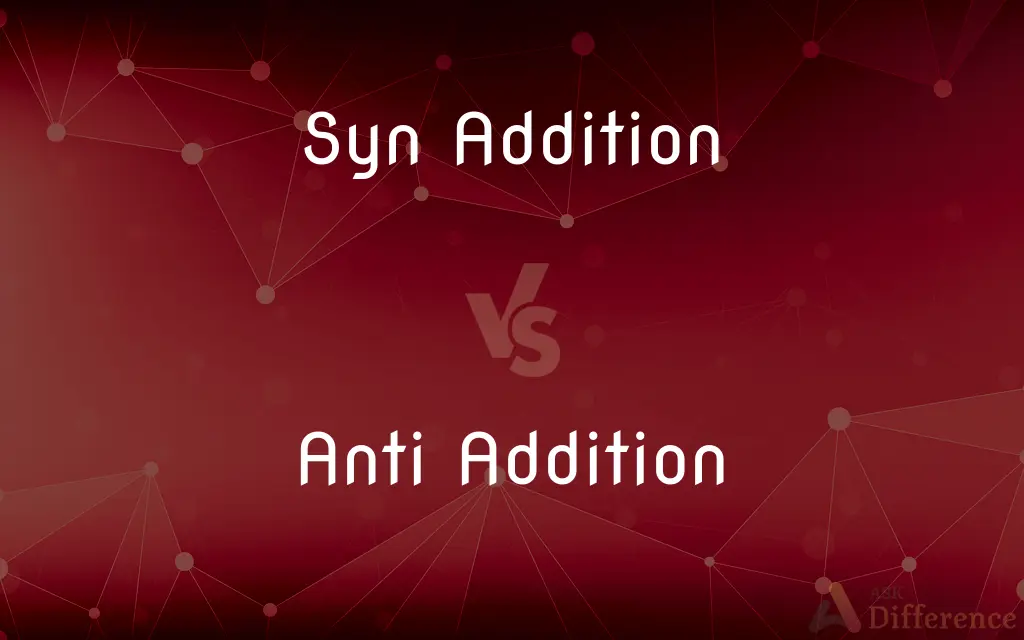Syn Addition vs. Anti Addition — What's the Difference?
By Tayyaba Rehman — Published on December 11, 2023
Syn Addition and Anti Addition differ in the orientation of substituents added across a double bond: syn means same side, while anti means opposite sides.

Difference Between Syn Addition and Anti Addition
Table of Contents
ADVERTISEMENT
Key Differences
Syn Addition is a chemical reaction where two substituents are added to a double bond on the same side or face of the molecule. This means that if you were to imagine a molecule lying flat, the added groups would both be above or both below the molecule. In contrast, Anti Addition is when the two substituents are added to opposite faces of a molecule. This would mean one is added above, and the other is added below.
Syn Addition results in products that have substituents on the same plane or face, and it's particularly common in certain reactions like hydrogenation where hydrogen atoms are added across a double bond. On the other hand, Anti Addition results in products where the added groups are positioned diagonally from each other, resulting in a more staggered arrangement. Both Syn Addition and Anti Addition can be stereospecific, meaning the spatial arrangement of atoms in the starting molecule dictates the spatial arrangement in the product.
In the context of organic chemistry, understanding the difference between Syn Addition and Anti Addition is crucial because it can determine the properties and reactions of the resulting compounds. Both Syn Addition and Anti Addition can lead to the formation of chiral centers, which are atoms bonded to four different groups, resulting in non-superimposable mirror images called enantiomers. However, the way these centers form and the resulting stereochemistry is greatly influenced by whether the addition was syn or anti.
Lastly, Syn Addition and Anti Addition aren't arbitrary terms or mere theoretical concepts. They're based on experimental evidence and can significantly impact the physical and chemical properties of molecules. The difference in orientation can lead to variations in melting points, boiling points, reactivity, and even biological activity in drug molecules.
Comparison Chart
Orientation
Substituents add to the same side of the bond.
Substituents add to opposite sides.
ADVERTISEMENT
Common Reaction
Hydrogenation
Halogenation
Resultant Geometry
Cis (in cases of cyclic compounds)
Trans (in cases of cyclic compounds)
Chirality
Can create chiral centers.
Can also create chiral centers.
Biological Relevance
May produce specific enantiomer in drugs.
Can produce different enantiomer in drugs.
Compare with Definitions
Syn Addition
A chemical process where groups add to the same side of a molecule.
In the hydrogenation of alkenes, Syn Addition leads to the cis isomer.
Anti Addition
A mode of addition where two groups add from different directions.
The ozonolysis of alkenes often proceeds through an Anti Addition pathway.
Syn Addition
A mode of addition where two groups add from the same direction.
The hydroboration of alkenes is a classic example of Syn Addition.
Anti Addition
A stereospecific addition where substituents are on opposite sides.
The epoxidation of alkenes, followed by opening with water, exhibits Anti Addition.
Syn Addition
An addition mechanism resulting in similar spatial orientation of added groups.
Alkenes reacting with certain metal catalysts often show Syn Addition.
Anti Addition
A chemical process where groups add to opposite sides of a molecule.
In the bromination of alkenes, Anti Addition results in the trans isomer.
Syn Addition
The attachment of groups to the same face of a double bond.
The reaction of alkenes with boron hydrides often follows a Syn Addition pathway.
Anti Addition
The attachment of groups to opposing faces of a double bond.
Halogens reacting with alkenes typically follow an Anti Addition mechanism.
Syn Addition
A stereospecific addition where substituents are on the same side.
In certain catalytic reactions, alkenes undergo Syn Addition to form cis products.
Anti Addition
An addition mechanism resulting in opposite spatial orientation of added groups.
Alkenes reacting with halogen-containing solvents often show Anti Addition.
Common Curiosities
Can Syn Addition produce chiral centers?
Yes, Syn Addition can create chiral centers depending on the starting material and added groups.
How does Syn Addition differ from Anti Addition?
In Syn Addition, substituents are added to the same side of a bond, while in Anti Addition, they're added to opposite sides.
Does Syn Addition always lead to cis products?
While Syn Addition commonly leads to cis products, the outcome can depend on the reaction and conditions.
Does Anti Addition lead to trans products?
In many cases, Anti Addition leads to trans products, but it can vary with reaction type and conditions.
What is Syn Addition in organic chemistry?
Syn Addition is a reaction where two groups add to the same side or face of a molecule.
Is Syn Addition more common than Anti Addition?
The prevalence of one over the other depends on the specific reaction and conditions involved.
What determines whether a reaction undergoes Syn Addition or Anti Addition?
The nature of the reactants, the reaction conditions, and the mechanism determine the type of addition.
What's a common reaction showcasing Syn Addition?
Hydrogenation of alkenes often follows a Syn Addition mechanism.
What is Anti Addition in organic chemistry?
Anti Addition is when two groups add to opposite sides or faces of a molecule.
Is Anti Addition observed in halogenation reactions?
Yes, halogenation of alkenes often follows an Anti Addition mechanism.
Can Anti Addition produce chiral molecules?
Yes, Anti Addition can also lead to the formation of chiral centers.
How does the orientation in Syn Addition and Anti Addition affect molecular properties?
The orientation can influence properties like melting points, reactivity, and biological activity.
Can both Syn Addition and Anti Addition produce enantiomers?
Yes, both types of additions can lead to the formation of enantiomers.
Why is understanding Syn Addition and Anti Addition crucial in organic chemistry?
Understanding them is key because they determine properties and potential reactions of resulting compounds.
Are Syn Addition and Anti Addition theoretical concepts or based on real observations?
Both concepts are based on experimental evidence and have significant implications in chemistry.
Share Your Discovery

Previous Comparison
Leopard vs. Snow Leopard
Next Comparison
Que vs. LineAuthor Spotlight
Written by
Tayyaba RehmanTayyaba Rehman is a distinguished writer, currently serving as a primary contributor to askdifference.com. As a researcher in semantics and etymology, Tayyaba's passion for the complexity of languages and their distinctions has found a perfect home on the platform. Tayyaba delves into the intricacies of language, distinguishing between commonly confused words and phrases, thereby providing clarity for readers worldwide.
















































